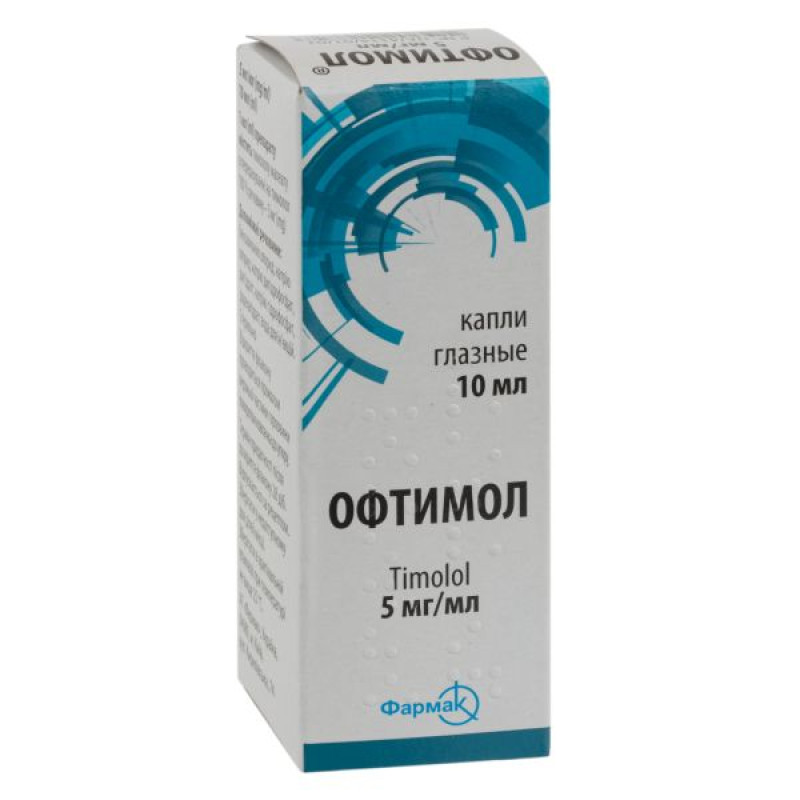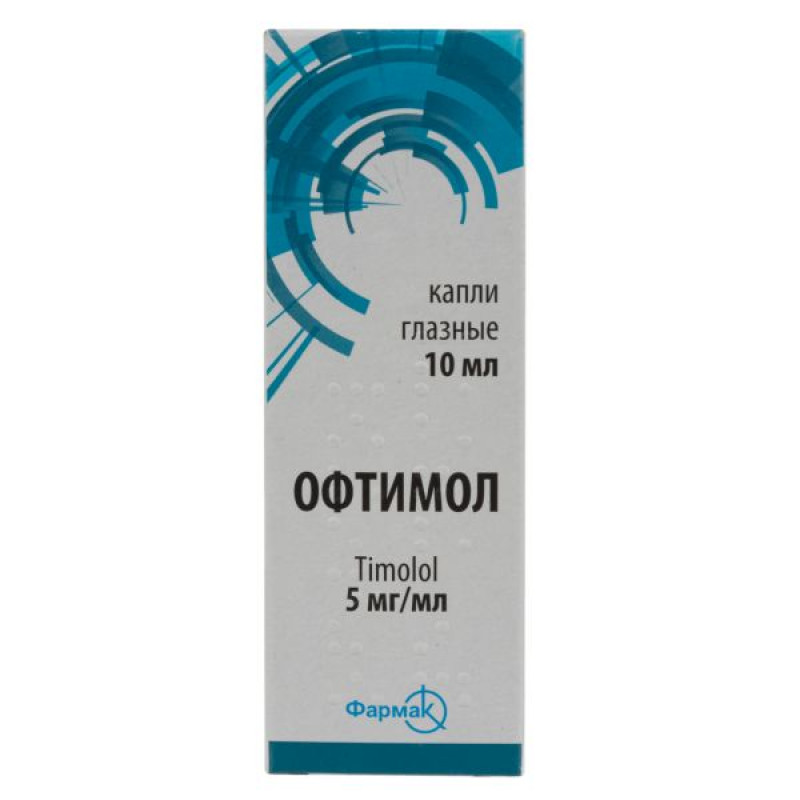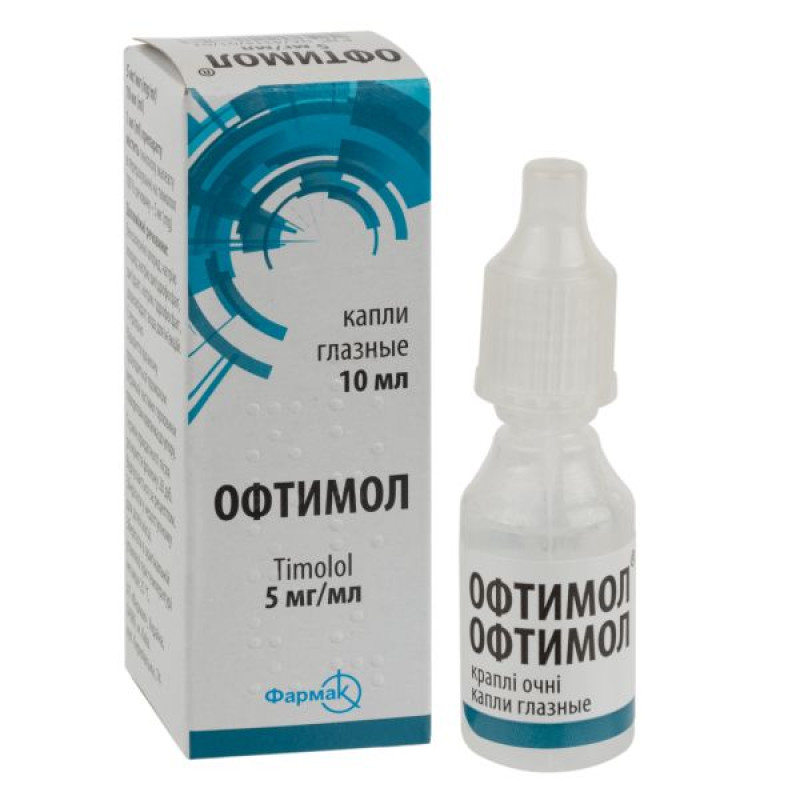Oftimol 0.5% eye drops 5 mg/ml bottle 10 ml

Instructions for use: Oftimol 0.5% eye drops 5 mg/ml, 10 ml bottle
Composition
active ingredient: timolol;
1 ml of the drug contains timolol maleate, calculated as timolol 100% substance 5 mg;
Excipients: benzalkonium chloride; sodium chloride; sodium dihydrogen phosphate, dihydrate; sodium hydrogen phosphate, dodecahydrate; water for injections.
Dosage form
Eye drops.
Main physicochemical properties: clear colorless liquid.
Pharmacotherapeutic group
Drugs used in ophthalmology. Antiglaucoma drugs and miotics. Beta-adrenergic blockers.
ATX code S01E D01.
Pharmacological properties
Pharmacodynamics.
Timolol is a non-selective (β1 and β2) β-blocker that has no significant intrinsic sympathomimetic or membrane-stabilizing activity, nor does it have a direct depressant effect on the myocardium.
Ophthalmic use of timolol maleate effectively reduces normal and elevated intraocular pressure. Based on the results of fluorometry, timolol maleate reduces the formation of intraocular fluid without significantly affecting the outflow of fluid. The cellular mechanisms of the reduction in the production of intraocular fluid in the processes occurring in the ciliary body of the eye are not yet fully understood.
Unlike treatment with miotics, timolol reduces intraocular pressure without affecting accommodation or pupil size or visual acuity; therefore, blurred or dim vision or impaired vision in bright light does not occur. In addition, in patients with cataracts, visual disturbances due to constricted pupil caused by lens opacification are avoided.
Pharmacokinetics.
The drug begins to act 20 minutes after instillation. Usually, a decrease in intraocular pressure can be detected 30 minutes after instillation. The maximum decrease is achieved within 1-2 hours. The decrease in intraocular pressure is maintained for 24 hours after a single dose.
Indication
Ocular hypertension, chronic open-angle glaucoma and some cases of secondary glaucoma.
Contraindication
Hypersensitivity to the active substance or to any of the excipients of the drug.
Diseases accompanied by airway hyperreactivity, including bronchial asthma or a history of bronchial asthma, severe chronic obstructive pulmonary disease.
Sinus bradycardia, sick sinus syndrome, sinoatrial block, second or third degree atrioventricular block not controlled by a pacemaker, severe heart failure or cardiogenic shock.
Interaction with other medicinal products and other types of interactions
No drug interaction studies have been performed with timolol. Increased systemic beta-blocking effects (e.g., decreased heart rate, depression) have been reported during combined treatment with CYP2D6 inhibitors (e.g., quinidine, fluoxetine, paroxetine) and timolol.
There may be an additive effect resulting in hypotension and/or marked bradycardia when beta-blocker eye drops are administered concomitantly with oral calcium channel blockers, beta-blockers, antiarrhythmics (including amiodarone), digitalis glycosides, parasympathomimetics, and guanethidine.
Mydriasis has been rarely reported following the concomitant use of beta-blockers in the form of eye drops and adrenaline (epinephrine).
If more than one ophthalmic medicinal product is used topically, an interval of at least 5 minutes should be observed between instillations. Eye ointments should be used last.
Application features
For ophthalmic use only.
General
Timolol is absorbed systemically, like other topically applied ophthalmic drugs.
Due to the presence of a beta-adrenergic blocking component, the use of timolol in ophthalmic practice may cause adverse reactions from the cardiovascular, respiratory and other systems, similar to those observed with the use of systemic β-blockers. The incidence of systemic adverse reactions after topical ophthalmic use is lower than with systemic use. In order to reduce systemic absorption, see the information given in the section "Method of administration and dosage".
Cardiac disorders
In patients with cardiovascular disease (e.g. coronary artery disease, Prinzmetal's angina and heart failure) and hypotension, beta-blocker treatment should be carefully evaluated and treatment with other active substances should be considered. Patients with cardiovascular disease should be monitored for signs of worsening of their condition and for possible adverse reactions. Due to the negative effect on impulse conduction time, beta-blockers should be administered with great caution to patients with first degree heart block.
Vascular disorders
Respiratory system disorders
Respiratory adverse reactions, including fatal bronchospasm in patients with asthma, have been reported following the use of some ophthalmic beta-blockers.
Oftimol® should be used with caution in patients with mild to moderate chronic obstructive pulmonary disease and only if the potential benefit outweighs the potential risk.
Hypoglycemia/diabetes
Because beta-blockers may mask the signs and symptoms of acute hypoglycemia, beta-blockers should be prescribed with caution in patients prone to spontaneous hypoglycemia or with labile diabetes.
Hyperthyroidism
Beta-blockers may mask the signs of hyperthyroidism.
Muscle weakness
Beta-blockers have been reported to exacerbate muscle weakness associated with certain symptoms of myasthenia gravis (e.g., diplopia, ptosis, and general weakness).
Corneal diseases
Ophthalmic beta-blockers may cause dry eyes and should be used with caution in patients with corneal disease.
Other beta-blockers
The effect on intraocular pressure or the known effects of systemic beta-blockers may be potentiated when timolol is administered to patients already receiving a systemic beta-blocker. Such patients should be carefully monitored for their response. The concomitant use of two topical beta-blockers is not recommended (see Interactions with other medicinal products and other forms of interaction).
Anaphylactic reactions
While taking beta-blockers, patients with a history of atopy or severe anaphylactic reactions to various allergens may be more sensitive to repeated exposure to such allergens and insensitive to the usual doses of adrenaline that are usually used to treat anaphylactic reactions.
Choroid detachment
Choroid detachment has been reported with the use of aqueous humor suppressing therapy (e.g., timolol, acetazolamide) after trabeculotomy.
Anesthesia during surgical procedures
Ophthalmic beta-blockers may block the systemic effects of beta-agonists, such as adrenaline. The anaesthetist should be informed that the patient is receiving timolol.
Contact lenses
Benzalkonium chloride may cause irritation and is known to discolor soft contact lenses. Contact with soft contact lenses should be avoided. Patients should be advised to remove contact lenses before instilling Oftimol® and to wait at least 15 minutes before reinsertion.
Use during pregnancy or breastfeeding
Reproductive function.
There are no data on the effect of Oftimol® on reproductive function.
Pregnancy
There are no adequate data on the use of Oftimol® in pregnant women.
Epidemiological studies have not revealed a teratogenic effect, but have demonstrated a risk of intrauterine growth retardation with oral administration of beta-blockers. In addition, signs and symptoms of beta-blocker effects in the newborn (e.g. bradycardia, hypotension, respiratory distress and hypoglycaemia) have been observed when beta-blockers were used antepartum. Timolol should not be used during pregnancy unless clearly necessary. However, if Oftimol® is used antepartum, the newborn should be closely monitored by a physician during the first days of life. Information on reduced systemic absorption is provided in the section "Method of administration and dosage".
Breast-feeding
Beta-blockers pass into breast milk and can cause serious adverse effects in a breastfed infant.
After a careful benefit/risk assessment, breastfeeding should be discontinued or Oftimol® therapy should be discontinued, taking into account the benefit of breastfeeding for the child and the benefit of therapy for the woman.
The ability to influence the reaction speed when driving or working with other mechanisms
Temporary blurred vision or other visual disturbances, including refractive changes, diplopia, ptosis, common cases of mild and temporary blurred vision and rare cases of dizziness or fatigue may affect the ability to drive or use machines.
If blurred vision occurs during instillation, the patient should wait until vision clears before driving or operating machinery.
Method of administration and doses
Attention! Do not screw the bottle cap tightly before use! Before the first use, screw it as far as possible. In this case, the spike located on the inside of the cap pierces the hole. Immediately before use, hold the bottle with the drug in the palm of your hand to warm it to body temperature. Unscrew the cap, remove it and, slightly pressing on the bottle body, drip the solution into the eye. After instillation, screw the cap tightly and store the drug according to the recommendations given in the instructions. Eye drops should be used with maximum hygiene. Do not touch the edge of the dropper to any surface.
Adults: Instill 1 drop of 0.25% timolol solution (use the appropriate concentration of timolol) into the affected eye(s) twice daily. If the result is unsatisfactory, use a 0.5% solution. If intraocular pressure is not adequately controlled, concomitant therapy with miotics, epinephrine, or systemic carbonic anhydrase inhibitors may be initiated. If adequate reduction in intraocular pressure is observed during treatment, maintenance therapy should be continued with 1 drop of the drug per day.
Method of application
The drops should be instilled by pulling the lower eyelid down.
The bottle should be kept closed when the patient is not using the drug.
Systemic absorption is reduced after nasolacrimal occlusion or eyelid closure for 2 minutes. This may result in reduced systemic side effects and increased local activity.
Children
The safety and efficacy of Oftymol® in children have not been established.
Overdose
There are no data on overdose of the drug. In case of overdose with Oftimol®, treatment should be supportive and symptomatic. Accidental ingestion of the contents of the bottle may cause symptoms of beta-blocker overdose, including bradycardia, hypotension, heart failure and bronchospasm.
In case of overdose, the following measures should be taken:
1. If the drug has entered the body orally, take activated charcoal. Studies have shown that timolol maleate is not removed by hemodialysis.
2. Symptomatic bradycardia: atropine sulfate 0.25 to 2 mg intravenously should be administered to induce vagal blockade. If bradycardia persists, isoprenaline hydrochloride should be administered intravenously with caution. In persistent cases, pacemaker therapy should be considered.
3. Hypotension: Sympathomimetics such as dopamine, dobutamine or noradrenaline should be used. In persistent cases, glucagon is useful.
4. Bronchospasm: Isoprenaline hydrochloride should be administered. Concomitant therapy with aminophylline may be considered.
5. Acute heart failure: conventional therapy with digitalis glycosides, diuretics and oxygen should be started immediately. In persistent cases, intravenous aminophylline is recommended.
If necessary, glucagon can be used afterwards, which is also effective.
6. Heart block: isoprenaline hydrochloride or a pacemaker should be used.
Side effects
The following adverse reactions have been reported in clinical trials with timolol and are classified as follows: very common (≥ 1/10), common (≥ 1/100 to < 1/10), uncommon (≥ 1/1,000 to < 1/100), rare (≥ 1/10,000 to < 1/1,000), rare (< 1/10,000). Within each frequency grouping, adverse reactions are presented in order of decreasing seriousness.
| Organ systems | Adverse reactions (according to MedDRA (version 15.1)) |
| Mental disorders | Rare: depression |
| From the nervous system | Uncommon: headache Rare: cerebral ischemia, dizziness, migraine |
| From the organs of vision | Common: blurred vision, eye pain, eye irritation, eye discomfort, eye redness Uncommon: corneal erosion, punctate keratitis, keratitis, iritis, conjunctivitis, blepharitis, decreased visual acuity, photophobia, dry eyes, increased lacrimation, eye discharge, eye itching, eyelid margin scaling, anterior chamber inflammation, eyelid edema, conjunctival hyperemia. Rare: uveitis, diplopia, asthenopia, eyelid eczema, eyelid erythema, eyelid pruritus, conjunctival edema, corneal pigmentation |
| From the heart | Uncommon: bradycardia Rare: myocardial infarction |
| From the vascular side | Uncommon: hypotension Rare: increased blood pressure, peripheral edema, cold extremities |
| Respiratory, thoracic and mediastinal disorders | Uncommon: asthma, bronchitis, dyspnoea Rare: chronic obstructive pulmonary disease, bronchospasm, cough, wheezing, nasal congestion |
| Gastrointestinal tract | Uncommon: altered taste Rare: indigestion, abdominal discomfort, dry mouth |
| Skin and subcutaneous tissue disorders | Rare: facial swelling, redness |
| General disorders and administration site conditions | Uncommon: fatigue Rare: general weakness, chest discomfort |
Brief overview of the safety profile
The most common adverse reactions in clinical trials with timolol were eye redness and irritation, occurring in approximately 5% and 2% of patients, respectively.
Additional adverse reactions identified during post-marketing surveillance were as follows. Based on the available data, it is not possible to estimate their frequency.
Within each system organ class, adverse reactions are presented in order of decreasing seriousness.
| Organ systems | Adverse reactions (according to MedDRA (version 15.1)) |
| On the part of the immune system | angioedema, hypersensitivity |
| Metabolism and nutrition | hypoglycemia | Mental disorders | insomnia, memory loss, nightmares |
| From the nervous system | stroke, fainting, paresthesia |
| From the organs of vision | choroid detachment (after trabeculotomy), eyelid ptosis |
| From the heart | cardiac arrest, atrioventricular block (complete, incomplete or worsening), congestive heart failure (worsening), arrhythmia, palpitations |
| From the vascular side | Raynaud's disease |
| Gastrointestinal tract | vomiting, diarrhea, nausea |
| Skin and subcutaneous tissue disorders | hives, psoriasis, rash, hair loss |
| Musculoskeletal and connective tissue disorders | arthropathy |
| Genital and breast disorders | sexual dysfunction |
Description of identified adverse reactions
As with other topical ophthalmic drugs, timolol is absorbed into the systemic circulation. This may lead to the same undesirable effects as those observed with systemic beta-blockers. The incidence of systemic adverse reactions after topical ophthalmic use is lower than after systemic use. These adverse reactions include those observed within the class of ophthalmic beta-blockers. Additional adverse reactions have been observed with ophthalmic beta-blockers and may potentially occur with Oftimol®:
On the part of the immune system: systemic lupus erythematosus, systemic allergic reactions, including angioedema, urticaria; limited and generalized rashes, itching, anaphylactic reaction.
Metabolism and nutrition disorders: hypoglycemia.
On the part of the psyche: insomnia, depression, nightmares, memory loss.
Nervous system: syncope, stroke, cerebral ischemia, increased signs and symptoms of myasthenia gravis, dizziness, paresthesia, and headache.
On the part of the organs of vision: signs and symptoms of eye irritation (e.g. burning, stinging, itching, tearing, redness), blepharitis, keratitis, blurred vision and choroid detachment after trabeculotomy (see section "Special instructions"), decreased corneal sensitivity, dry eyes, corneal erosion, ptosis, diplopia, visual disturbances, including changes in refraction (in some due to discontinuation of therapy with miotics).
On the part of the auditory system: tinnitus.
Cardiac: bradycardia, chest pain, palpitations, edema, arrhythmia, congestive heart failure, atrioventricular block, cardiac arrest, heart failure.
Vascular: hypotension, Raynaud's disease, cold extremities.
On the part of the respiratory system, chest organs and mediastinum: bronchospasm (especially in patients with a history of bronchial and lung diseases), dyspnea, cough, respiratory failure.
Gastrointestinal: change in taste, nausea, indigestion, diarrhea, dry mouth, abdominal pain, vomiting.
Skin and subcutaneous tissue disorders: hair loss, psoriatic eruptions or exacerbation of psoriasis, skin rashes.
Musculoskeletal and connective tissue disorders: myalgia, arthralgia.
From the genitals and breast: sexual dysfunction (impotence), decreased libido.
General disorders and administration site conditions: general weakness/fatigue.
The following adverse reactions have been reported with systemic timolol therapy: pain in the extremities, decreased exercise capacity, increased sweating, exfoliative dermatitis, drowsiness, difficulty urinating, hyperglycemia, nonspecific thrombocytopenic purpura, Peyronie's disease.
Expiration date
3 years. After opening the bottle, the drug is suitable for 28 days.
Do not use the drug after the expiration date indicated on the package.
Storage conditions
Store in the original packaging at a temperature not exceeding 25 ºС.
Keep out of reach of children.
Packaging
5 ml or 10 ml in a bottle enclosed in a pack.
Vacation category
According to the recipe.
Producer
JSC "Farmak".
Address
Ukraine, 04080, Kyiv, Kyrylivska St., 74.
There are no reviews for this product.
There are no reviews for this product, be the first to leave your review.
No questions about this product, be the first and ask your question.








